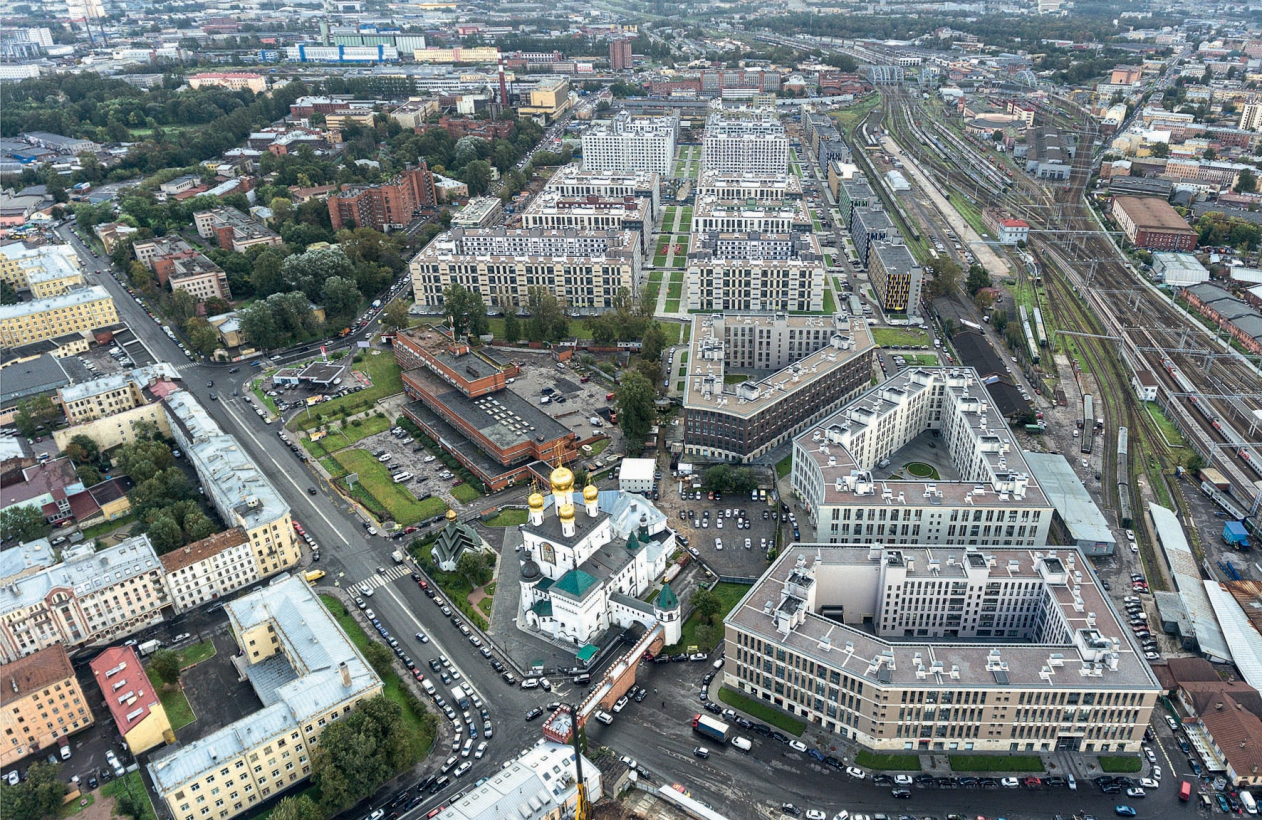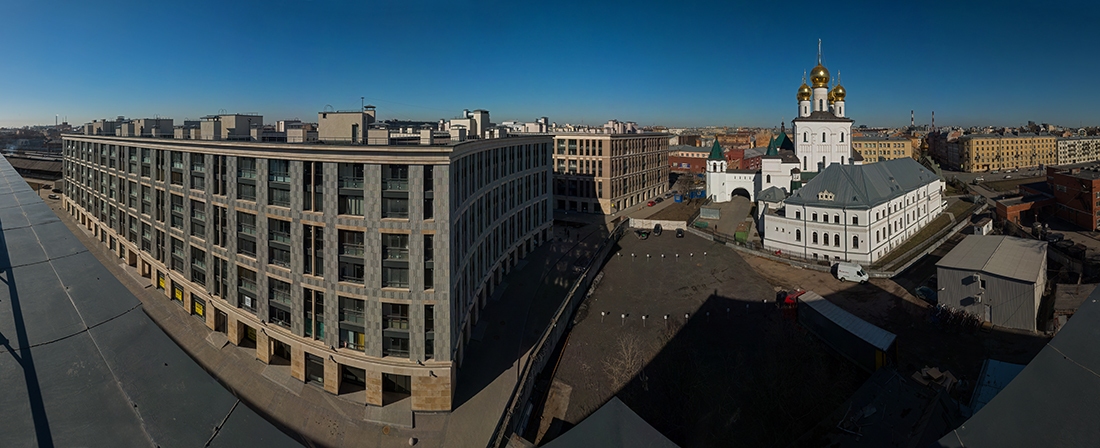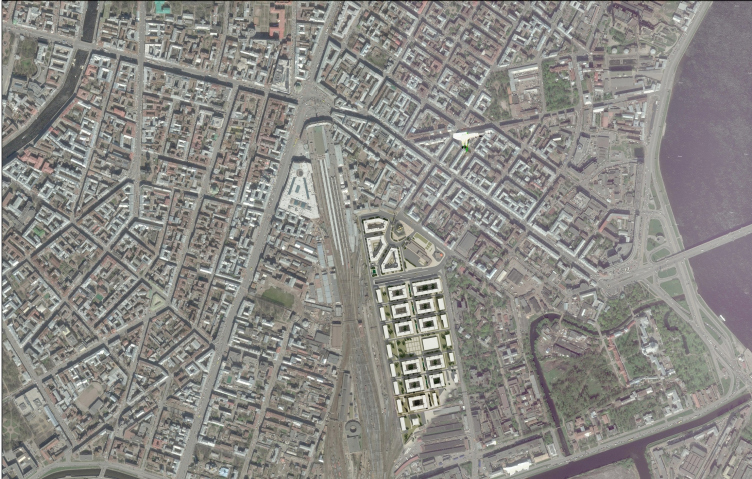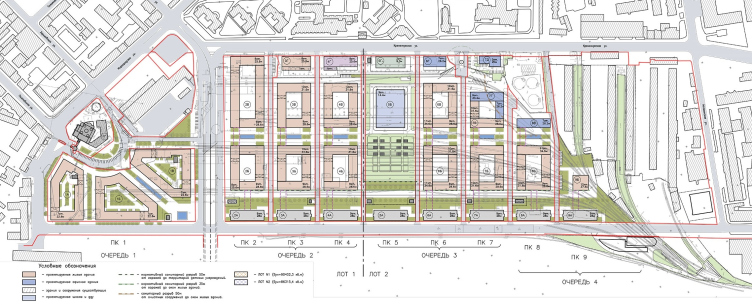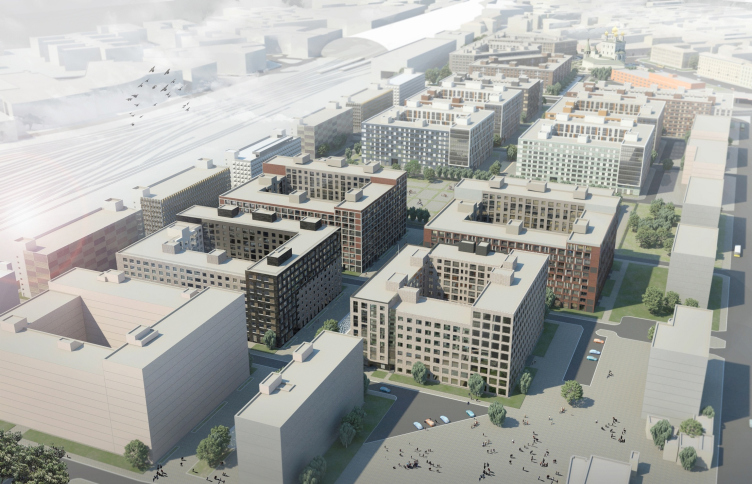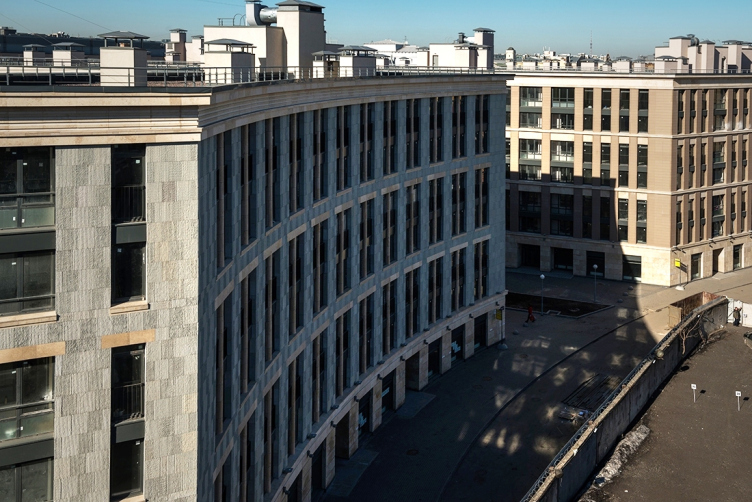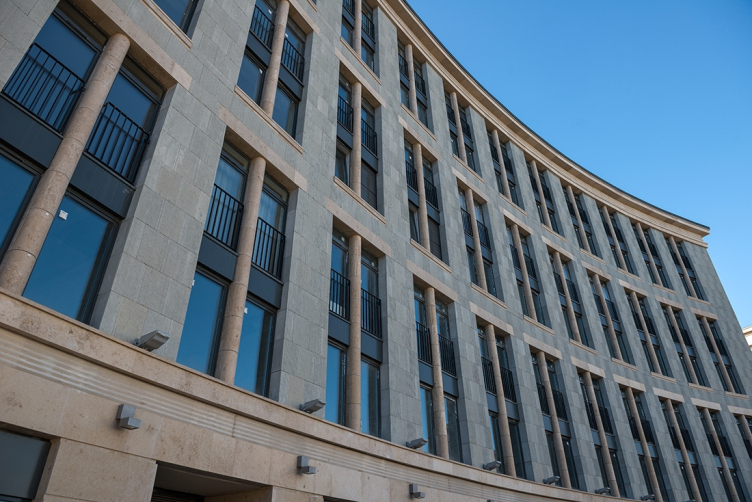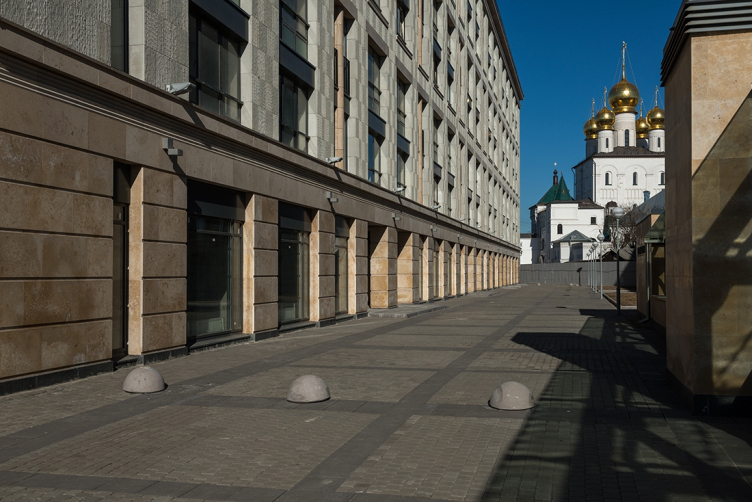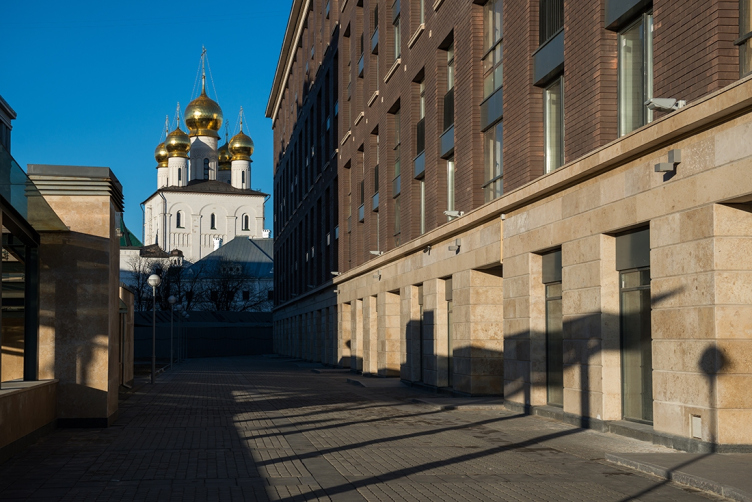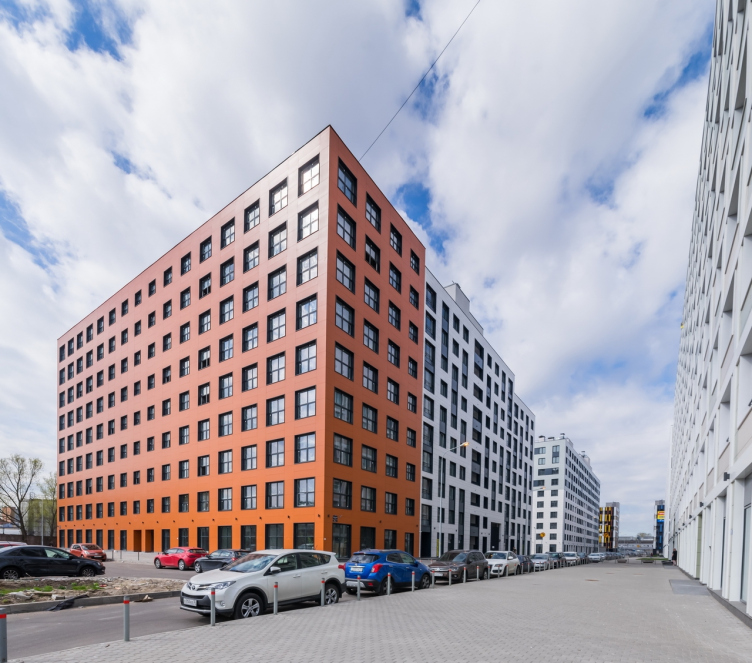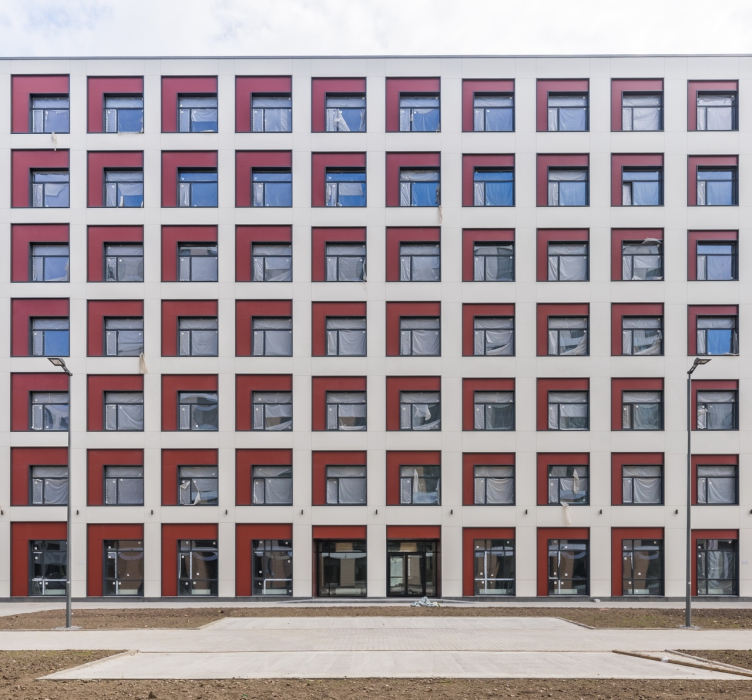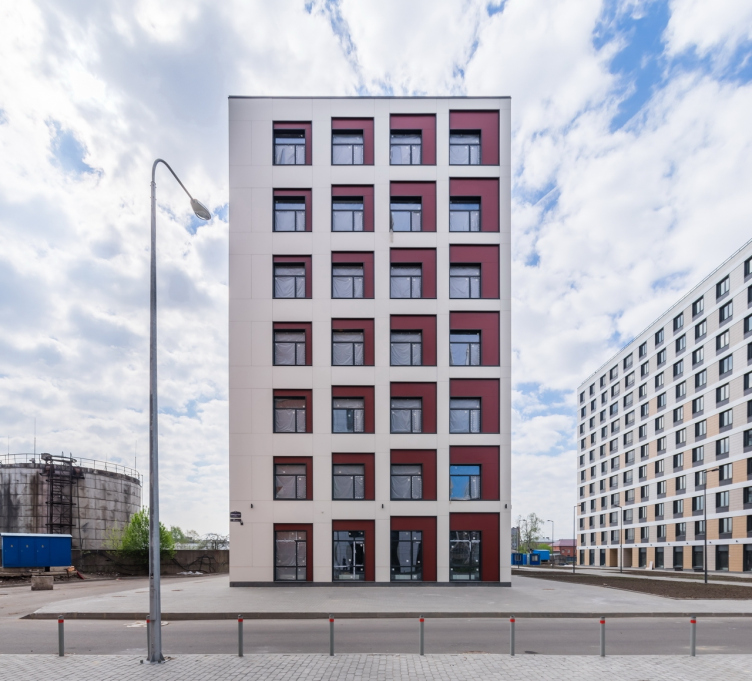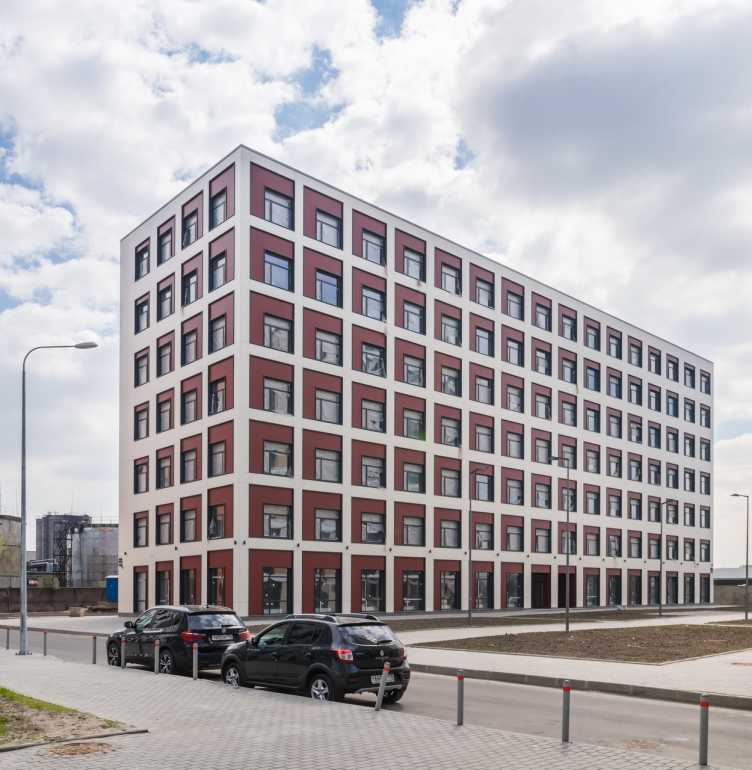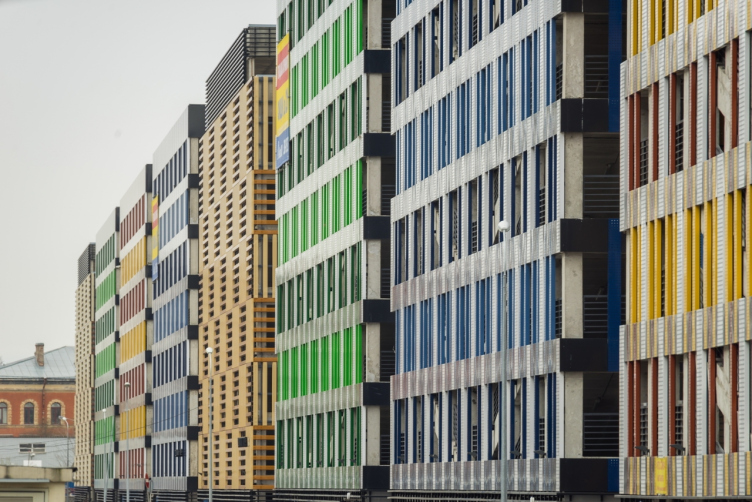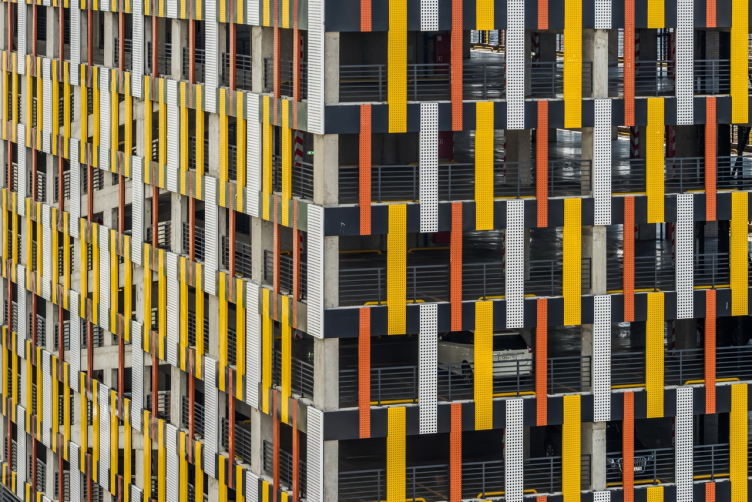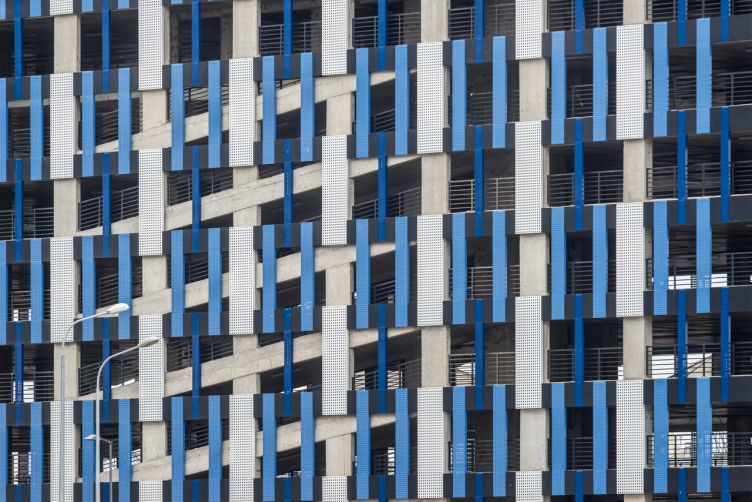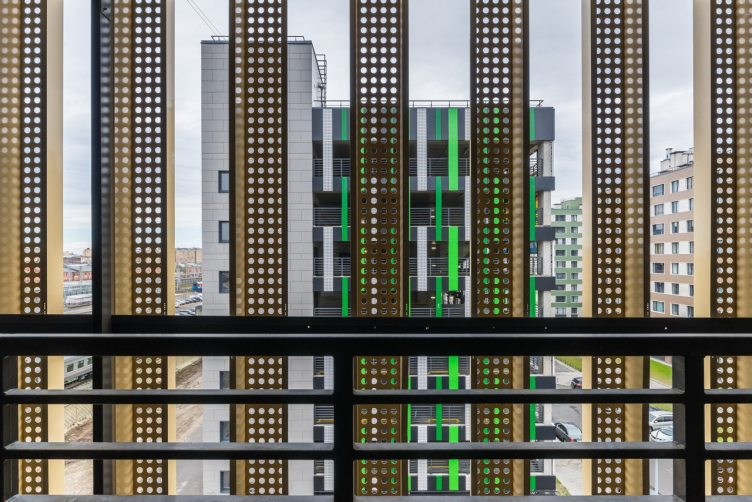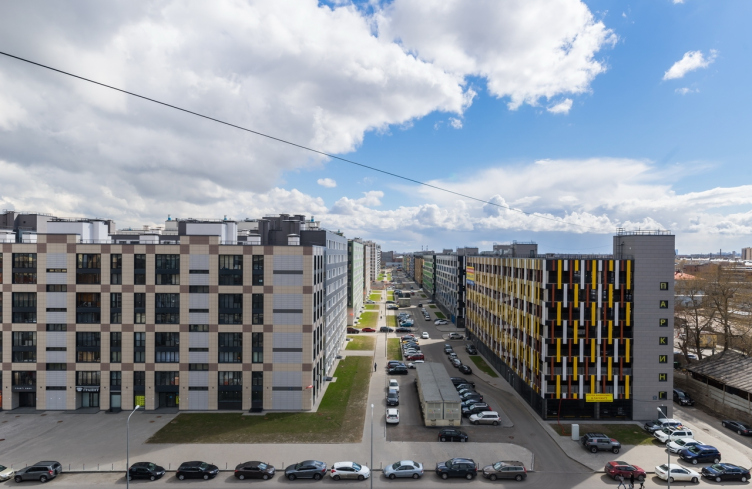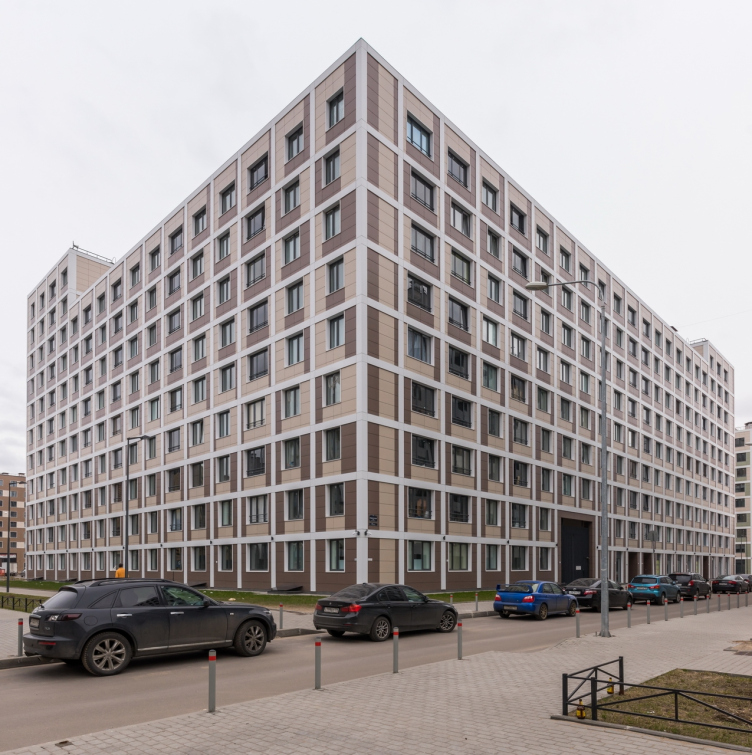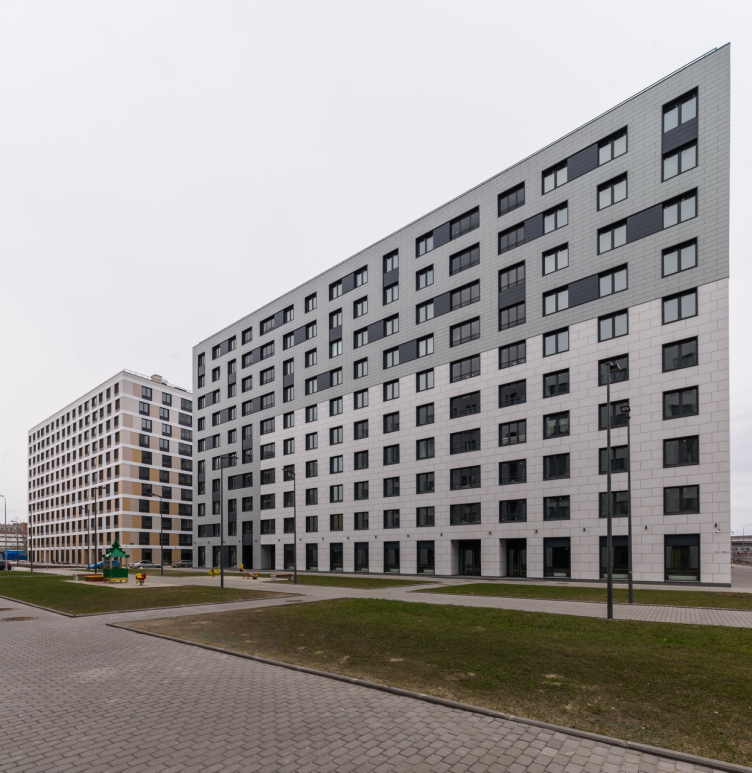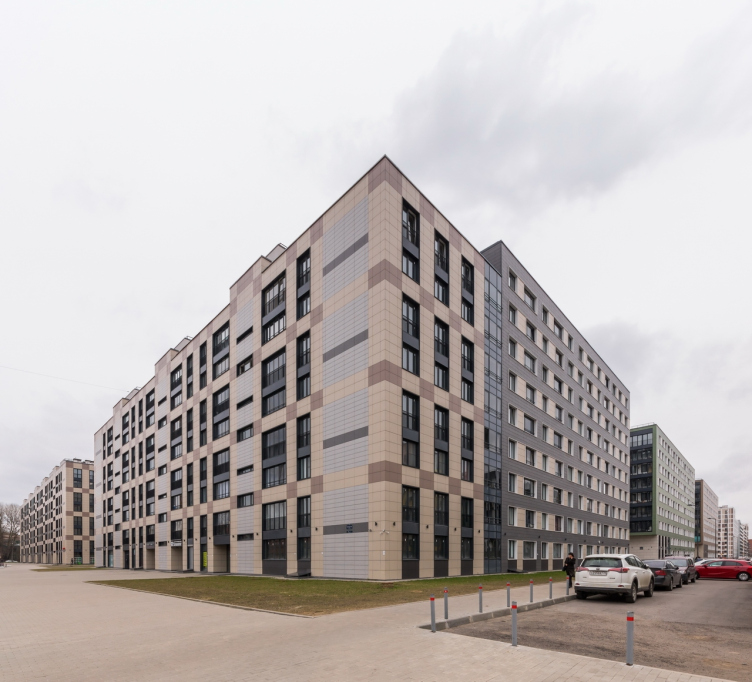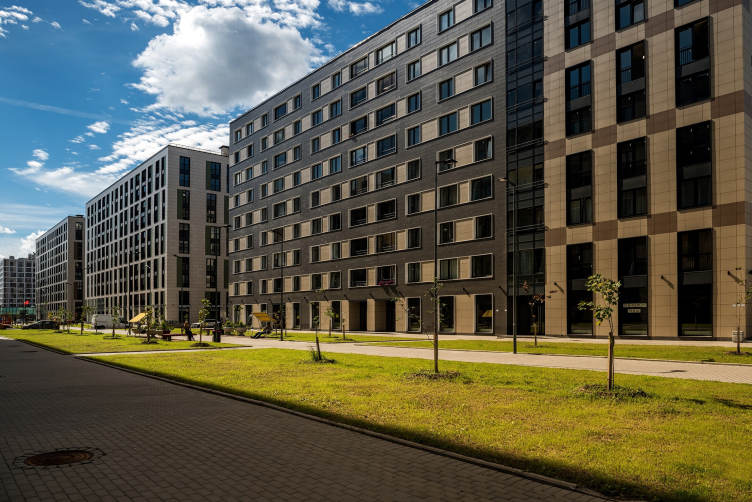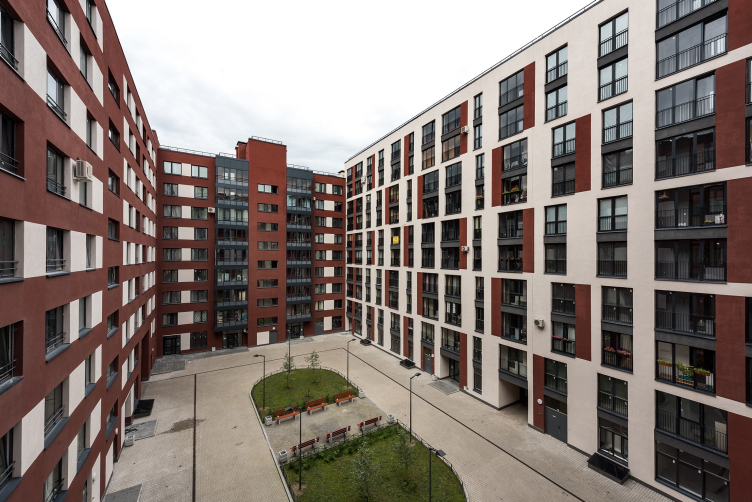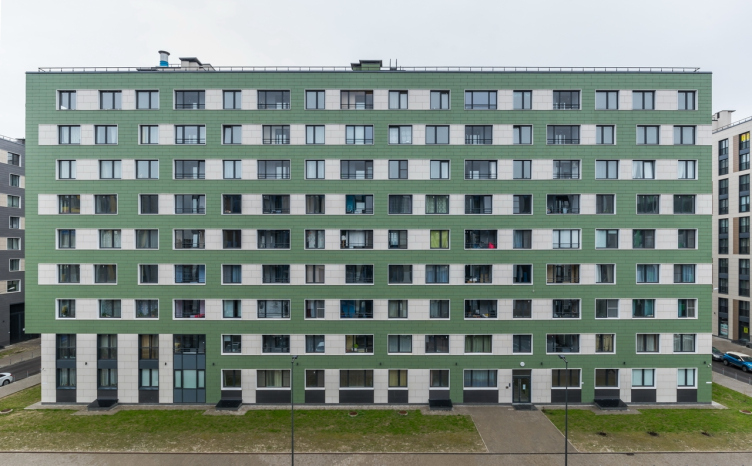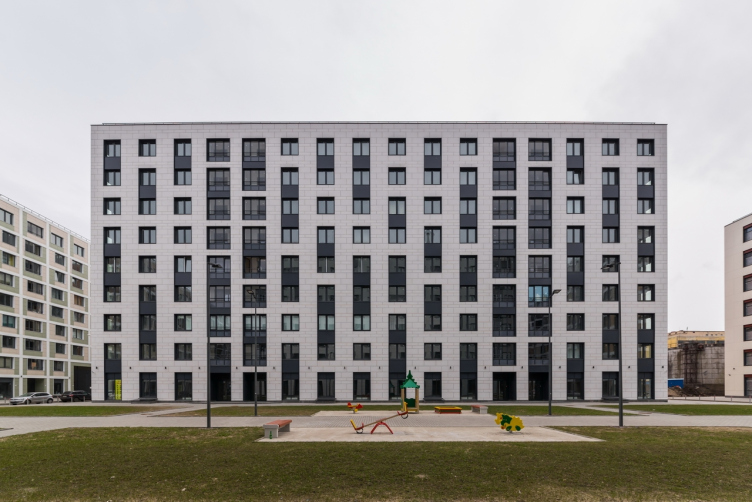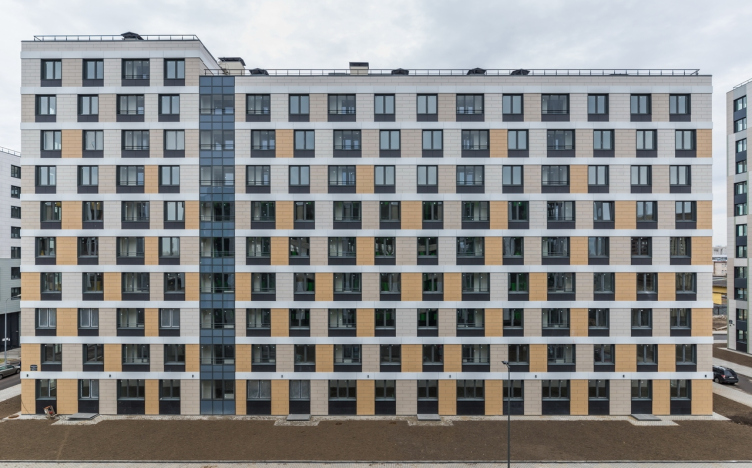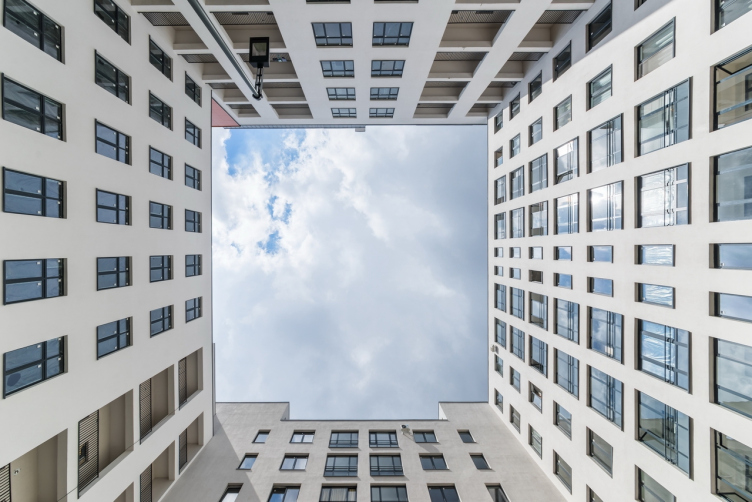The land site with which Evgeny Gerasimov started working still in 2011, according to the architect himself, was essentially a lost world “in the vein of Conan Doyle”: overgrown with weeds, lopsided abandoned houses were roamed by stray dogs. And, what’s more, all this was taking place but a five minutes’ walk away from the Nevsky Prospect, next to the Moskovsky Railway Terminal, the Alexander Nevski Monastery, and the Gallery, the city’s main shopping mall.
Before the renovation, this territory was occupied by the loading bay of the station “Saint Petersburg freight Moscow” that by 2009 was transferred by the Russian Railways to the city of Shushary. The large almost-20-hectare trapeze-shaped site stretches between the Kremenchugskaya Street and the Oktyabrskaya Railroad, along which it is planned to organize a regular city street. On the Kremenchugskaya Street, the nearest neighbors of “Tsarskaya Stolitsa” are historical buildings of the Botkin Infection Clinic; some of these were built in the XIX century, some belong to the constructivist tradition. It must be also noted that there has been a lot of talk about moving the clinic outside the city center as well. From the south side, in the direction of the Bypass Channel, there is more of undeveloped land, while from the north the new residential area is opened up by the Theodor Cathedral, a cultural heritage building that was built for the 300th anniversary of the Romanov Dynasty. According to Evgeny Gerasimov, it was this cathedral that became the starting point, the “jewel”, for which the frame was ultimately created.
"Tsarskaya Stolitsa" housing complex © Evgeny Gerasimov and Partners
"Tsarskaya Stolitsa" housing complex.Location plan © Evgeny Gerasimov and Partners
One of the main tasks that the architects were to solve was a town-planning one. It was important to organize the pedestrian and vehicle streams, make sure the new buildings do not obscure the cathedral, and, possibly, set the tone for the construction of the future neighbors. At the end of the day, the architects came up with a simple yet efficient plan: two traversal drive-through streets cut through an orthogonal in-block grid strung on the longitudinal axis of a pedestrian boulevard. The cells of this grid contain residential houses or blocks, each with a courtyard of its own. In the center, the architects left a vacant space for the future school. This way, a certain hierarchy of city streets and squares was formed: there are public spaces belonging to the city – the cathedral square and the boulevard, and there are private ones – the closed resident-only yards, and there are “intermediate” ones, i.e. streets of local importance.
“Tsarskaya Stolitsa” housing complex. A drone photo
Copyright: © Evgeniy Gerasimov & Partners
"Tsarskaya Stolitsa" housing complex. Construction sketch © Evgeny Gerasimov and Partners
"Tsarskaya Stolitsa" housing complex. Stages 3, 2 ,1 © Evgeny Gerasimov and Partners
Yet another task was to minimize the possible negative factors arising from the proximity of the railroad line and the infection clinic. From the railroad side, the residential buildings are fenced off by multilevel parking garages that essentially function as a giant noise screen. From the other side, the noise coming from the Kremenchugskaya Street will be dampened by the buildings of another complex: a business center, a hotel, a shopping mall, and yet another residential building is being built upon a different project developed by “Evgeny Gerasimov and Partners” in collaboration with SPEECH.
Totally, “Tsarskaya Stolitsa” consists of fifteen residential buildings constructed in four stages. The first stage is dramatically different from the rest because the three closed-circuit trapeze-shape blocks that constitute it run in a radiant fan-like fashion away from the cathedral, encircling its west and south façades in an arc-shaped square. These buildings are ostentatiously austere, classical and respectable-looking – they can put one in the mind of the buildings surrounding the Mussolini square of Emperor August in Rome, even the semi-columns in these windows look like the banisters of the balconies in Rome. The base floors and the in-built cornices of light-colored Jurassic lime look really great against the background of the “body” of the buildings designed in a darker tone, one house coated with dark brown brick, another – with ceramic tiles with a subtle pattern of horizontal stripes, a third one – with ripped greenish tufa, whose play of colors on a sunny day looks like moiré ribbon. The low window sills are grouped in twos, the glass of the stanza balconies sunken in to the level of the window apertures (just like in all the other buildings of the complex). Their strict vertical rhythm is gathered into moderate horizontal registers.
"Tsarskaya Stolitsa" housing complex © Evgeny Gerasimov and Partners
"Tsarskaya Stolitsa" housing complex © Evgeny Gerasimov and Partners
The buildings that make up the square are respectable and conservative – they are just enough to create here a feeling of transition to the historical Saint Petersburg that begins right across the street behind the cathedral, on the Mirgorodskaya and Poltavskaya streets. On the other side, the rays of the two streets between the blocks are routed in such a way that the cathedral is also viewable from the railroad. And, by all means, the very appearance of a semicircular square in Saint Petersburg, at the south end of the Nevsky Prospect, cannot but resonate, at least to some extent, with the Palace Square, or the Joint Staff, looking very much like their replica or reflection. But then again, the associations are unobtrusive, and this square might just as well fit in with a whole number of arc-shaped classicist squares, all the more so because the very presence of the main accent – the temple – prompted such a solution in more ways than one.
"Tsarskaya Stolitsa" housing complex © Evgeny Gerasimov and Partners
“Tsarskaya Stolitsa” housing complex
Copyright: © Evgeniy Gerasimov & Partners
The cathedral got a frame it truly deserved; Eugene Gerasimov was so into it that he even entered the guardian council on recreating the temple. “The meaning of this cathedral is very much of a literary type – the architect shares: the European Saint Petersburg meets its Moscow guests with a temple in the Old Russian style, as if to make sure that nobody feels like a stranger here”. The architectural image of the cathedral – which is a characteristic trait of the 1910’s temple construction – is rather eclectic: it includes Rostov, Vladimir, Pskov, and Suzdal motifs.
Thus, the first buildings of “Tsarskaya Stolitsa” pay homage to the cathedral and the historical city; they are critical for creating a smooth transition from the old to the new.
The second, third, and fourth stages are definitely a modern city. The further away from the cathedral, the bolder the façades become. The techniques are really numerous here: the play of colors and textures, combination of verticals and horizontals, optical illusions, windows of different sizes, asymmetry, and complex rhythms. The buildings turned out bright, dramatic, of the “Instagram” kind but not garish – exactly in the taste of the millennials, for whom, possibly, this entire complex was designed: living around here, you can get pretty much everywhere by foot, and even Moscow is but a train ride away, the nearby railroad and clinic being as much of a romantic twist for these people as they would have normally been a nuisance.
Buildings with the bolder design solutions will be occupied by offices: these are a luscious orange one (with differently sized windows) and a milky-white one (whose windows look as if they grow out of the building and sink into it – thanks to the technique very much like grisaille). The last residential building, the only one that does not have a courtyard here, becomes like a period in this architectural sentence.
"Tsarskaya Stolitsa" housing complex © Evgeny Gerasimov and Partners
"Tsarskaya Stolitsa" housing complex © Evgeny Gerasimov and Partners
"Tsarskaya Stolitsa" housing complex © Evgeny Gerasimov and Partners
"Tsarskaya Stolitsa" housing complex © Evgeny Gerasimov and Partners
"Tsarskaya Stolitsa" housing complex © Evgeny Gerasimov and Partners
"Tsarskaya Stolitsa" housing complex © Evgeny Gerasimov and Partners
The brightest in the whole complex are the parking garage buildings. They are decorated in two ways: with colored perforated slabs or with grilles. Totally, there are seven of them, and, as we remember, they line up along the railroad tracks protecting the residential buildings from the noise.
"Tsarskaya Stolitsa" housing complex © Evgeny Gerasimov and Partners
"Tsarskaya Stolitsa" housing complex © Evgeny Gerasimov and Partners
"Tsarskaya Stolitsa" housing complex © Evgeny Gerasimov and Partners
"Tsarskaya Stolitsa" housing complex © Evgeny Gerasimov and Partners
"Tsarskaya Stolitsa" housing complex © Evgeny Gerasimov and Partners
"Tsarskaya Stolitsa" housing complex © Evgeny Gerasimov and Partners
"Tsarskaya Stolitsa" housing complex © Evgeny Gerasimov and Partners
This railroad line that runs through this place is doubtlessly yet another genius loci. Viewed in the spaces between the houses, streams of cars are yet another horizontal accent that at some points supports the façade lines, and at some points competes with them. Together with the cathedral, the railroad fills the area with sound: the muffled horns and the dispatcher’s voice, and then the real magic of the sound of the tolling bells reflecting from the walls. This gives you a feeling that is as unusual and fresh as it is long-forgotten.
Jane Jacobs and Jan Gehl would have probably been pleased with “Tsarskaya Stolitsa”. The sidewalks here are uncommonly wide by Saint Petersburg standards, and they are protected from the traffic by special pillars. The pedestrian and vehicle streams are comfortably divided. The buildings look really human-proportionate. The closed yards are completely secured, while the streets have “eyes” of their own: the windows and balconies overlook both courtyards and pedestrian sidewalks and promenades which, in all likelihood, will soon be bustling with life: all the ground floors are public ones, almost all of them are covered by the banners announcing the openings of future cafés, studios, and salons. From these banners one can also draw a conclusion that this area will be populated by people with different income levels: one can see here the “Pyaterochka” discounter, a premium-class dentist office, steak houses, and bakeries. The apartments range from studios to five-room ones, reasonably priced by Saint Petersburg standards.
"Tsarskaya Stolitsa" housing complex © Evgeny Gerasimov and Partners
"Tsarskaya Stolitsa" housing complex © Evgeny Gerasimov and Partners
"Tsarskaya Stolitsa" housing complex © Evgeny Gerasimov and Partners
"Tsarskaya Stolitsa" housing complex © Evgeny Gerasimov and Partners
"Tsarskaya Stolitsa" housing complex © Evgeny Gerasimov and Partners
"Tsarskaya Stolitsa" housing complex © Evgeny Gerasimov and Partners
"Tsarskaya Stolitsa" housing complex © Evgeny Gerasimov and Partners
"Tsarskaya Stolitsa" housing complex © Evgeny Gerasimov and Partners
"Tsarskaya Stolitsa" housing complex © Evgeny Gerasimov and Partners
"Tsarskaya Stolitsa" housing complex © Evgeny Gerasimov and Partners
"Tsarskaya Stolitsa" housing complex © Evgeny Gerasimov and Partners
"Tsarskaya Stolitsa" housing complex © Evgeny Gerasimov and Partners
“Tsarskaya Stolitsa” is one of the largest projects of renovating and redeveloping former industrial parks of Saint Petersburg (a similar story happened on the Petrogradskaya Side where Evgeny Gerasimov and Sergey Tchoban designed the “Europe-City” complex). The past of this place is still readable. There is tall weed shooting up between the new buildings; at some places the houses stand pushed against concrete fences, brand-new façades neighbor on hangars, wooden warehouses, and even balls of barbed wire. But it’s clear that pretty soon this place will “comb itself up”, and its surroundings will eventually follow suit. “Tsarskaya Stolitsa” is promising to become an attraction point for most diverse city flows. And gracefully combining these flows is probably exactly what any city must be about.

